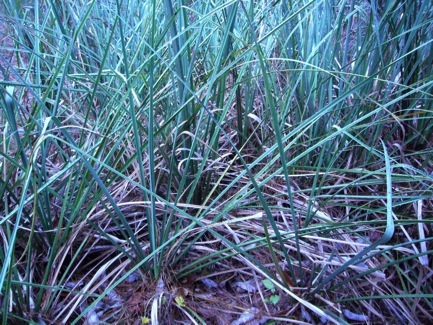Cladium jamaicense: Water finder
In Wekiva Springs state park in Florida there is a high and dry stretch of scrub pine and palmetto bushes, and oddly, a bunch of water-loving sawgrass. The area is dotted with little and gigantic springs and the sawgrass pictured left, in that dry environment, is the only indication of the spring underneath. Normally it is found in standing water.
Sawgrass gets a lot of bad press. Even though it covers most of the Everglades and its relatives can be found in most of North America except the northern plains, few have anything good to say about it. Apparently even most animals avoid it. But, It is edible. However, I didn’t say it was easy to get at.
Sawgrass is correctly and incorrectly named. First it is not a grass but a sedge. Sedges have edges, grass have stems. But the saw part is right. In fact, in Haiti it is call the “razor herb.”
The sedge is armed with very fine saw teeth and will cut you quite easily (though a useable blade in nature if you need one.) The heart of leaves at the bottom are edible. They taste similar to heart of palm but not as sweet. Some say the young shoots are edible but I don’t see how. Elsewhere in the world some sawgrasses have edible roots. Sawgrass roots are too tough.
Its botanical name is Cladium jamaicense (KLA-dee-um ja-may-KEN-see.) Cladium is from the Greek word kladion, or branchlett, referring to the flower spike. It was named by botanist Patrick Browne in 1766. The other native species are C. mariscoides (latin: mar-is-COY-dees Greek mar-is-KEE- deez) and C. californicum (ka-li-FOR-ni-cum.) Edibility unknown to me. A species in the old world is Cladium mariscus (mar-RISK-us.)
Oddly enough, the top of sawgrass often has little worms in it that are excellent bait for fresh water fish.
Green Deane’s “Itemized” Plant Profile
IDENTIFICATION: A tall, coarse,perennial to nine feet, usually three; leaves long and thin, flat V-shaped blades with sharp teeth on the edges and underside mid-vein. Flowers rusty brown spikes up to 3 feet long above the leaves. Leaves tend to cut one way, when pulling away from the plant.
TIME OF YEAR: Grows year round in Florida, summer and fall elsewhere.
ENVIRONMENT: Edges of wetlands or freshwater lakes. Grow in a scrub area usually means a spring nearby.
METHOD OF PREPARATION: Inner bottom white core of stalk, raw or cooked. WARNING: It cuts flesh very easily.


